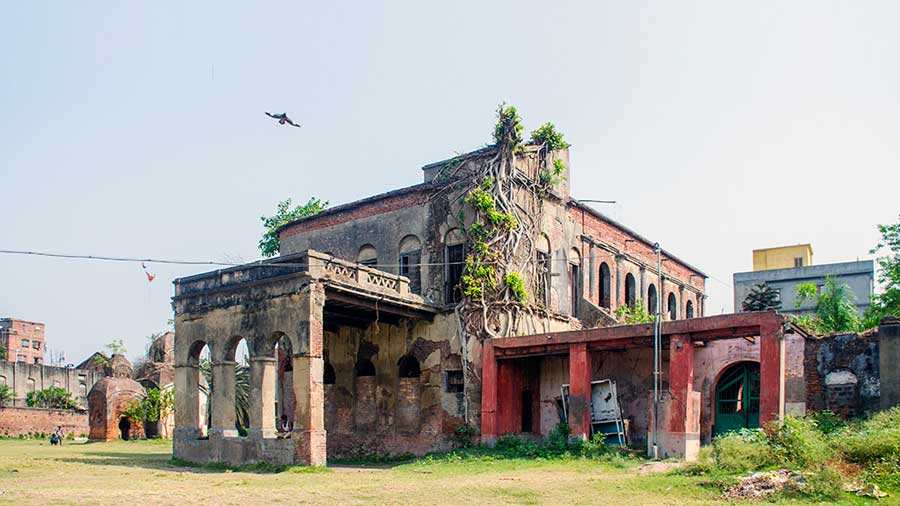A monastery in the Himalayas makes for a common sight. But what if you stumbled upon a monastery in the plains of Bengal? That too, right by to the Hooghly River?
Bhot Bagan, translating to ‘Tibetan garden’, located in the winding lanes of Howrah’s Ghusuri, dates back to 1780 and is considered to be the oldest Tibetan Buddhist monastery outside the Himalayas. The dilapidated monastery complex can be approached via a maze of bylanes on Gossain Ghat Street. Locally known as Mahakal Math, the monastery may be difficult to locate if you rely solely on Google Maps. Locals may prove to be of more help.
Legend has it…
Though it was conceived as a haven of spiritual peace, the history of Bhot Bagan is steeped in conflict — between the Kingdom of Bhutan and the princely state of Cooch Behar. The East India Company under the leadership of Hastings had decided to help the king of Cooch Behar, who wanted to drive the Bhutanese population away. At this point, the Panchen Lama intervened. He offered a peace settlement. Panchen Lama sent an envoy, a Hindu monk by the name of Puran Giri Gosain (or Goswami).

The main monastery building houses a portion of the collapsed roof
Puran Giri who was popularly known as Purangir, was a member of the Dashanami Sampradaya, a Hindu monastic tradition founded by Adi Shankara Acharya. Worshippers of Shiva, the Gosains were a unique class of trading monks, who were so rich and powerful that they often had private armies to guard trading routes. Hastings, who was on the lookout for a trade relationship with China, took advantage of the situation and welcomed Purangir. On the other hand, Panchen Lama and the Tibetans, who have also always considered India a holy land, wanted to build a monastery on Indian plains, which is how Bhot Bagan was conceived.

The Bhot Bagan complex
Back to the roots…
In December, 1775, the East India Company leased 30 bighas of land to Purangir, in Howrah’s Ghusuri. Within a short time, temples and buildings started coming up and 30 bighas expanded to 150 bighas of freehold land. From the very beginning, Bhot Bagan has been a place of mixed religions, combining Hinduism and Buddhism along with tantric practices.
In the early days, several items were brought from Tibet by the Panchen Lama, which included idols of Mahakal and Tara. Along with that came 100 pieces of gold, carpets and cloth banners. The idol of Mahakal, however, was the main attraction. It was made of precious metal and had nine heads, 18 legs and 36 arms, each clasping a weapon and one holding on to a female consort.

The idol of Tara in the Bhot Bagan shrine
Sadly, Bhot Bagan was raided by armed dacoits in 1795. Though Purangir gallantly resisted the dacoits, he was killed in action. The dacoits fled with the prized idol of Mahakal. Today, the idol of Tara occupies the place of Mahakal.
In 1905, the Gosain lineage ended as their last member died without a legal heir. Presently, the Bhot Bagan Math has been under the control of a court-appointed receiver. The Tiwari family serves as the caretaker of the property and a local priest conducts the daily puja, following Hindu rights. Recently Bhot Bagan came under the supervision of the West Bengal Heritage Commission.

The temple housing the idol of Tara
Nothing much remains of the Buddhist monastery today. The 150 bighas have shrunk to a measly six bighas during the course of time. The main building with its thick pillars still stands, although a large portion of the roof has collapsed. Local boys can often be seen playing cricket in the large field surrounding the building.
The temple is located next to the main building and has been restored to an extent. It’s usually only opened for pujas and upon special request. The idol of Tara is placed inside a metal grill chamber and is locked. Next to the idol of Tara is another chamber housing a Shiva Linga.

The Gossain tombs in the monastery
Apart from the main building, the complex also has twin Shiva temples on the western side. On the east, several temple-like structures can be spotted, which are overgrown with vegetation. These are not temples, but tombs. The Gosains were not cremated after death, but were rather buried and some tombs, resembling temples, were erected above their graves. Today, seven of the nine tombs still stand – but in a dilapidated condition.
So, as it happens, an ancient Tibetan Buddhist monastery on the Indian plains is in desperate need of attention. If Bhot Bagan crumbles to dust, it will not just wipe out a crucial chunk of history, but also a significant archive of cultural synthesis.
Rangan Datta is a mathematics and management teacher by profession and a travel writer and photographer by passion. He has been addicted to discovering off-beat places since his undergraduate days at St. Xavier's College. Blogging and contributing to Wikipedia are his other passions.
